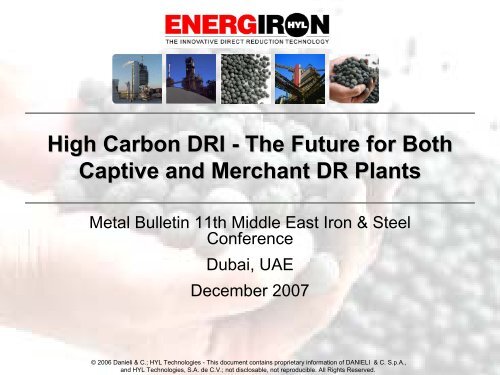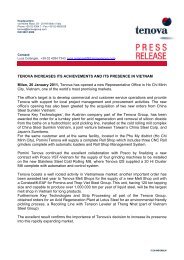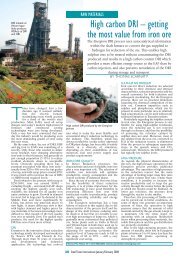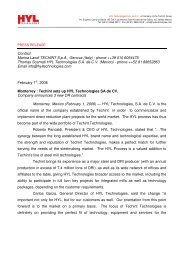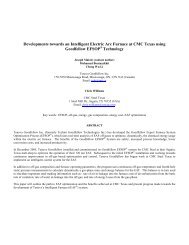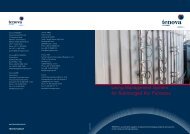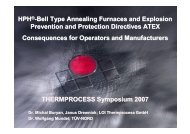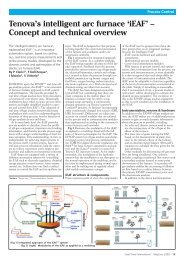High Carbon DRI - The Future for Both Captive and ... - Tenova
High Carbon DRI - The Future for Both Captive and ... - Tenova
High Carbon DRI - The Future for Both Captive and ... - Tenova
You also want an ePaper? Increase the reach of your titles
YUMPU automatically turns print PDFs into web optimized ePapers that Google loves.
<strong>High</strong> <strong>Carbon</strong> <strong>DRI</strong> - <strong>The</strong> <strong>Future</strong> <strong>for</strong> <strong>Both</strong><br />
<strong>Captive</strong> <strong>and</strong> Merchant DR Plants<br />
Metal Bulletin 11th Middle East Iron & Steel<br />
Conference<br />
Dubai, UAE<br />
December 2007<br />
© 2006 Danieli & C.; HYL Technologies - This document contains proprietary in<strong>for</strong>mation of DANIELI & C. S.p.A.,<br />
<strong>and</strong> HYL Technologies, S.A. de C.V.; not disclosable, not reproducible. All Rights Reserved.
Importance of <strong>DRI</strong><br />
• <strong>The</strong> Middle East region has become one of the highest growth areas <strong>for</strong><br />
steelmaking via the direct reduction - EAF route.<br />
• Natural gas availability <strong>and</strong> a strong growth in industrial <strong>and</strong><br />
commercial development have increased steel dem<strong>and</strong> significantly in<br />
the region.<br />
• While the majority of new direct reduction facilities here are planned <strong>for</strong><br />
onsite steel production, there is also merchant dem<strong>and</strong> which can be<br />
satisfied.<br />
• A key aspect of Energiron - the HYL DR technology from Danieli <strong>and</strong><br />
<strong>Tenova</strong> HYL - is that it produces a reduced product with very high<br />
levels of iron carbide, unlike any other DR product. Energiron <strong>DRI</strong>,<br />
when charged hot to an adjacent EAF provides significant operating<br />
<strong>and</strong> cost advantages <strong>for</strong> steelmaking, <strong>and</strong> the product when discharged<br />
cold is a highly stable material which can easily be transported to<br />
satisfy merchant requirements.
Importance of <strong>High</strong> <strong>Carbon</strong> <strong>DRI</strong><br />
• Energiron Technology<br />
Process <strong>High</strong>lights<br />
Product <strong>High</strong>lights<br />
• Quality product<br />
• Easy to transport <strong>and</strong> store<br />
• Better productivity <strong>and</strong> yield in EAFs<br />
• Better quality steel products<br />
• Only from Energiron process:<br />
Environmentally friendly<br />
Fully proven hot charging system
Energiron Technology<br />
• <strong>The</strong> ENERGIRON Process based on the ZR scheme, is a<br />
major step in reducing the size <strong>and</strong> improving the efficiency<br />
of direct reduction plants. Reducing gases are generated<br />
by in-situ in the reduction reactor, feeding natural gas as<br />
make-up to the reducing gas circuit <strong>and</strong> injecting oxygen at<br />
the inlet of the reactor.<br />
• Since all reducing gases are generated in the reduction<br />
section, taking advantage of the catalytic effect of the<br />
metallic iron inside the shaft furnace, optimum reduction<br />
efficiency is attained, <strong>and</strong> thus an external reducing gas<br />
re<strong>for</strong>mer is not required.<br />
• <strong>The</strong> basic ENERGIRON scheme permits the direct<br />
utilization of natural gas.
Energiron Technology<br />
• <strong>The</strong> basic scheme can also use the conventional steamnatural<br />
gas re<strong>for</strong>ming equipment, which has long<br />
characterized the process. Other reducing agents such as<br />
hydrogen, gases from gasification of coal, petcoke <strong>and</strong><br />
similar fossil fuels <strong>and</strong> coke-oven gas, among others, are<br />
also potential sources of reducing gas depending on the<br />
particular situation <strong>and</strong> availability.<br />
• Additionally, the DR plant can be designed to produce<br />
<strong>High</strong>-carbon <strong>DRI</strong>, hot <strong>DRI</strong>, which can be directly fed to<br />
adjacent EAF through the HYTEMP System or to<br />
briquetting units to produced HBI or any combination of<br />
these products.
Process <strong>High</strong>lights<br />
• <strong>High</strong> reduction temp. (above<br />
1050°C)<br />
• In-situ re<strong>for</strong>ming<br />
• Low use of thermal equipment<br />
Minimal energy losses<br />
• <strong>High</strong> pressure operation<br />
Minimal dust losses<br />
Increased productivity/m 2<br />
• Selective removal of by-products<br />
(H 2O <strong>and</strong> CO 2)<br />
Clean & Green<br />
CO 2 – merchant product<br />
NG<br />
NG<br />
CO 2<br />
Humidifier<br />
Fuel<br />
H 2 O<br />
Oxygen<br />
Oxygen<br />
Iron<br />
Ore<br />
<strong>DRI</strong>
Process Economics<br />
• As compared to other DR<br />
processes, the <strong>DRI</strong> <strong>and</strong> steel<br />
production costs through the<br />
ENERGIRON Technology is<br />
lower due to:<br />
Lower consumption of iron ore<br />
Lower total energy (thermal +<br />
electrical) consumption<br />
<strong>High</strong>-carbon content in <strong>DRI</strong>, with<br />
significant costs <strong>and</strong> productivity<br />
benefits in EAF<br />
Further reduction of production<br />
cost through use of low cost iron<br />
ores<br />
Cost (US$/t LS)<br />
250<br />
200<br />
150<br />
100<br />
50<br />
0<br />
Steel Production Cost<br />
ENERGIRON<br />
ZR Scheme<br />
Other DR<br />
Technology<br />
Others to EAF<br />
Oxygen to EAF<br />
<strong>Carbon</strong> to EAF<br />
Energy to EAF<br />
Others to DR<br />
Energy to DR<br />
Iron Ore
Process Economics<br />
Scenario<br />
Comparative Cost Analysis<br />
DR-EAF: ZR <strong>High</strong> <strong>Carbon</strong> <strong>DRI</strong> vs. Other Technology <strong>DRI</strong><br />
Scheme<br />
Other Cold <strong>DRI</strong><br />
94% Mtz.; 2% C<br />
ZR Cold <strong>High</strong>-C <strong>DRI</strong><br />
94% Mtz.; 3.7% C<br />
Other Hot <strong>DRI</strong><br />
94% Mtz.; 1.5% C<br />
ZR Hot <strong>High</strong>-C <strong>DRI</strong><br />
94% Mtz.; 3.7% C<br />
Production cost estimate/t LS 106.9% 103.6% 103.6% 100%<br />
Additional Operating cost Base: 225 $/t LS<br />
<strong>for</strong> 1.4 m tpy LS (million $US/y) 22.5 11.6 11.8 0<br />
Comparative EAF Productivity<br />
Pellets 100 $/t<br />
Natural gas 9.92 $/Gcal<br />
Electricity 0.045 $/kWh<br />
Oxygen 0.06 $/Nm 3<br />
Basis, costs <strong>for</strong>:<br />
C addition to EAF 0.14 $/kg<br />
75.8% 80.4% 91.6% 100%<br />
• Based on the benefits when using the high-C <strong>DRI</strong>, as<br />
compared to other <strong>DRI</strong> qualities/schemes, <strong>for</strong> a steel facility<br />
of 1.4 million tpy, savings can be as high as 12 million<br />
$/year.<br />
• Additional benefits are related to higher EAF productivity by<br />
using high-carbon <strong>DRI</strong>.
Product <strong>High</strong>lights<br />
• Widest range of product<br />
carbon (2 – 5%), as iron<br />
carbide<br />
• <strong>Carbon</strong> level is selective,<br />
not averaged<br />
• <strong>High</strong>ly metallized, high<br />
carbon <strong>DRI</strong> brings energy<br />
to the EAF<br />
• Lowest iron ore <strong>and</strong> gas<br />
requirements<br />
ZR Scheme-Typical Consumption Figures<br />
Item Unit<br />
Plant capacity t/a 200,000 - 2,000,000<br />
Metallization ≥ 94%<br />
<strong>Carbon</strong><br />
(controlled)<br />
2% - 5%<br />
Inputs<br />
Specific<br />
Consumption<br />
Iron ore t/t 1.35 - 1.40<br />
Natural gas Gcal/t 2.3<br />
Electricity kWh/t 60-80<br />
Oxygen Nm 3 /t 35<br />
Water m 3 1.2<br />
Labor m-h/t 0.11 - 0.17<br />
Maintenance US$ 3 - 3.3
<strong>High</strong> <strong>Carbon</strong> <strong>DRI</strong> Benefits - Safety<br />
• <strong>Carbon</strong> is mostly as<br />
iron carbide in<br />
outermost part of<br />
pellets<br />
• Carbide shell acts as<br />
inhibitor; improves<br />
stability
<strong>High</strong> <strong>Carbon</strong> <strong>DRI</strong> Benefits - Economy<br />
• Can be shipped without<br />
cost of briquetting<br />
• Reduces need <strong>for</strong><br />
carbon additions to the<br />
EAF<br />
• Increases yield <strong>and</strong><br />
productivity, especially<br />
when hot charged via<br />
HYTEMP System
<strong>High</strong> <strong>Carbon</strong> <strong>DRI</strong> Benefits – in EAF<br />
• <strong>Carbon</strong> is Energy <strong>and</strong> this energy is finally<br />
utilized at the EAF when the <strong>DRI</strong> is melted.<br />
• <strong>The</strong> <strong>Carbon</strong> will yield energy by the following<br />
reactions:<br />
2C + O2 ------> CO + Heat<br />
Fe3C ---> 3Fe + C + Heat<br />
• <strong>The</strong> combination of the above reactions will<br />
yield more than 37 kWh/tls per each 1%<br />
<strong>Carbon</strong> in the <strong>DRI</strong>.<br />
• Efficient use of carbon; as compared to other<br />
sources of carbon injection, while minimizing<br />
external carbon (graphite) additions,<br />
cementite in <strong>DRI</strong> is characterized by a higher<br />
recovery yield in the EAF.<br />
• Easy foamy slag generation; as high carbon<br />
<strong>DRI</strong> enters in contact with free or combined<br />
oxygen.<br />
• <strong>The</strong> same system controls the feeding rate of<br />
metallic charge <strong>and</strong> carbon additions.
Impact of <strong>Carbon</strong> <strong>and</strong> Temperature<br />
• Graphite injection is about 12 kg/tLS <strong>for</strong><br />
<strong>DRI</strong> with 2.2% carbon <strong>and</strong> 0.5 kg/tLS <strong>for</strong><br />
<strong>DRI</strong> with 4.0% carbon.<br />
• For these operating conditions, the<br />
change from 2.2% to 4% carbon in cold<br />
<strong>DRI</strong> represents a decrease of 11-kg<br />
graphite <strong>and</strong> 58-kWh/tLS.<br />
• This power saving is a result of the<br />
replacement of graphite by cementite<br />
related to yield <strong>and</strong> heat reaction.<br />
• On the other h<strong>and</strong>, hot <strong>DRI</strong> feed<br />
provides additional sensible heat to the<br />
EAF, reducing power consumption <strong>and</strong><br />
tap-to-tap time, which is additionally<br />
reflected in productivity increase. <strong>The</strong><br />
overall effect of:<br />
high-efficiency ZR scheme with<br />
minimum thermal <strong>and</strong> electricity<br />
consumption figures, <strong>and</strong><br />
use of hot <strong>and</strong>/or cold <strong>High</strong>-<strong>Carbon</strong><br />
<strong>DRI</strong> in EAF,<br />
• have an important impact on the overall<br />
energy dem<strong>and</strong> <strong>for</strong> steel production,<br />
decreasing overall plant emissions <strong>and</strong><br />
particularly CO2 release to atmosphere.<br />
650<br />
600<br />
550<br />
500<br />
450<br />
400<br />
350<br />
Effect of <strong>DRI</strong> Temperature <strong>and</strong> <strong>Carbon</strong><br />
on Electricity Consumption<br />
100% <strong>DRI</strong>; 2.2 %C, 25 Nm3/tls<br />
100% <strong>DRI</strong>; 4.0 %C, 42 Nm3/tls<br />
0 100 200 300 400 500 600 700<br />
<strong>DRI</strong> Temperature (ºC)
Impact of <strong>Carbon</strong> <strong>and</strong> Temperature<br />
KWH/TLS<br />
700<br />
600<br />
500<br />
400<br />
300<br />
200<br />
100<br />
0<br />
OtherMidrex processes<br />
92%M 1.5%C<br />
EAF Power consumption 100% <strong>DRI</strong><br />
HYL-ZR<br />
94%M 4%C<br />
HYL-ZR HYTEMP<br />
94%M 4%C 600°C
Keeping it Clean – Keeping it Green<br />
• For a DR plant, main gas <strong>and</strong> solids emissions are related to:<br />
Iron ore particulates from material h<strong>and</strong>ling.<br />
Iron ore <strong>and</strong> <strong>DRI</strong> particulates as sludge from process water system.<br />
Gaseous effluents from thermal equipment <strong>and</strong> degassing stacks of water<br />
systems.<br />
• Emissions from gaseous <strong>and</strong> aqueous effluents from a DR plant can be<br />
categorized in two main groups:<br />
Pollutants, such as: NOx, SOx, VOC, particulates, etc., which limits are<br />
defined by the environmental regulations of local Governments.<br />
Global Warming-Greenhouse emissions (GHG), which refer to gaseous<br />
compounds from natural <strong>and</strong> anthropogenic sources that absorb <strong>and</strong> reemit<br />
infrared radiation, enhancing the greenhouse effect. GHG comprises:<br />
CO2, CH4, N2O <strong>and</strong> HFCs, PFCs, SF6.<br />
• Compliance with the pollutants indicated in a) is m<strong>and</strong>atory to obtain<br />
governmental permits <strong>for</strong> the installation of the DR facility.
Energiron Plants <strong>and</strong> <strong>The</strong> Environment<br />
• An ENERGIRON plant complies with the strictest environmental<br />
regulations worldwide without the need of specific process<br />
requirements <strong>and</strong>/or additional equipment <strong>for</strong> treatment of heavy<br />
hydrocarbons in natural gas, sulfur in iron ore <strong>and</strong>/or de-NOx systems.<br />
• <strong>The</strong> amount of solids wastes is small because of the low gas velocities<br />
inside the shaft furnace due to the high operation pressure, which is<br />
reflected in low amount of carry-over particles in the gases.<br />
• A ncritical pollutant, NOx emission in flue gases, is a result of high<br />
flame temperatures at the fuel combustion system. For the<br />
ENERGIRON plant, the NOx is below environmental limits due to the<br />
overall energy integration of the ZR DR plant, which is possible without<br />
the need of huge air preheating <strong>for</strong> energy recovery.
Energiron Emissions Compliance -<br />
Example<br />
Gaseous<br />
Pollutants<br />
Minnesota, USA<br />
Environmental<br />
Regulation<br />
Achieved value in<br />
ENERGIRON plant<br />
Particulate 0.014 grains/dscf 0.01 grains/dscf None<br />
SO 2<br />
NOx<br />
CO<br />
Specific Environmental requirements as compared with emissions of the<br />
ENERGIRON DR plant<br />
15 lb/hr, 24-hour<br />
average.<br />
96 ppmv @ 3% O2 152 lb/hr, 24-hour<br />
average<br />
32 lb/hr, 24-hour<br />
average.<br />
14.1 lb/hr None<br />
85 ppmv (maximum)<br />
75 lb/hr<br />
16.6 lb/hr None<br />
VOC 2 lb/hr, 24-hour average 0 None<br />
Specific Method<br />
Just use of low NOx<br />
burners.
CO2 Emissions<br />
Scenario<br />
Location:<br />
CO2 Emissions / tonne of Liquid Steel<br />
DR-EAF: ZR <strong>High</strong> <strong>Carbon</strong> <strong>DRI</strong> vs. Other Technology <strong>DRI</strong><br />
Power generation: 0,74 kg CO2/kWh<br />
Other Cold <strong>DRI</strong> ZR Cold <strong>High</strong>-C <strong>DRI</strong> Other Hot <strong>DRI</strong> ZR Hot <strong>High</strong>-C <strong>DRI</strong><br />
Scheme<br />
94% Mtz.; 2% C 94% Mtz.; 3.7% C 94% Mtz.; 1.5% C 94% Mtz.; 3.7% C<br />
Item/unit kg CO2/t LS kg CO2/t LS kg CO2/t LS kg CO2/t LS<br />
Iron ore (production) 132 129 132 129<br />
CO2 in flue gases + removal system 447 455 455 461<br />
Electricity & O2 to DR plant 89 78 97 83<br />
Subtotal DR Plant 668 661 683 673<br />
Power & O2 requirements 441 412 337 302<br />
<strong>Carbon</strong> addition 35 3 59 3<br />
Subtotal EAF 476 416 397 305<br />
Total DR-EAF route 1144 1077 1080 978<br />
As % -6%<br />
-10%<br />
•<strong>The</strong> ENERGIRON ZR-based scheme reduces overall CO 2 emissions by 6% to 10% <strong>for</strong> cold <strong>and</strong> hot<br />
<strong>DRI</strong>, respectively, <strong>for</strong> liquid steel production.<br />
•By the selective elimination of CO2 to optimize reuse of reducing gases in the Energiron plant,<br />
there is an important potential <strong>for</strong> further CO2 emissions reduction of an additional 30%.
Latest Energiron Plants<br />
Plant Cap. (000) Start<br />
Ternium 4M, Monterrey, Mexico 0.90 1998<br />
Ternium 3M5, Monterrey, Mexico 0.50 2001<br />
Vikram Ispat-Grasim, India 0.60 2007<br />
Mittal Steel Lazaro Cardenas, Mexico 0.50 2007<br />
Ternium Sidor, Venezuela 0.80 2008<br />
Al Nasser Industrial Enterprises, Abu Dhabi 0.25 2009<br />
GHC, Abu Dhabi 1.70 2009<br />
Minnesota Steel Industries, USA 1.70 2009
Final Remarks<br />
• Energiron technology provides a UNIQUE<br />
product – <strong>High</strong> <strong>Carbon</strong> <strong>DRI</strong> (well above<br />
2.5%)<br />
• As iron carbide, it makes the <strong>DRI</strong> stable,<br />
safe to ship <strong>and</strong> allows higher yields <strong>for</strong><br />
steelmaking<br />
• <strong>The</strong> Energiron process does this all, while<br />
remaining the cleanest, most economical<br />
<strong>and</strong> reliable option available.
Final Remarks<br />
• <strong>The</strong> benefits of producing <strong>High</strong> <strong>Carbon</strong> <strong>DRI</strong><br />
are available to both captive <strong>and</strong> merchant<br />
producers<br />
For captive plants, feeding hot <strong>High</strong> <strong>Carbon</strong><br />
<strong>DRI</strong> to the EAF further increases benefits<br />
For merchant plants following IMO guidelines,<br />
the product can be shipped safely while avoiding<br />
the cost of producing briquettes.


